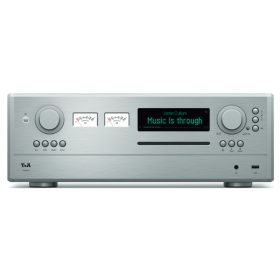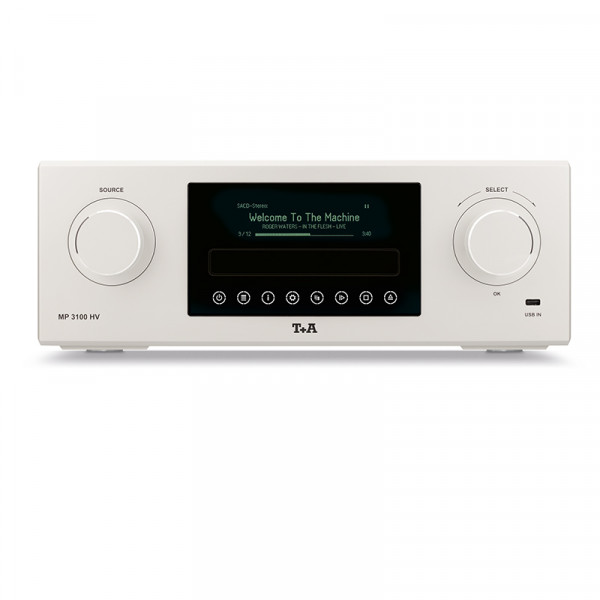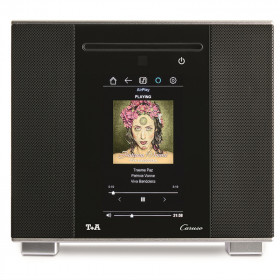






T+A MP 3100 HV

MP 3100 HV
The Multi Source SACD-Player
The Multi Source SACD-Player
The MP 3100 HV is our latest and most sophisticated multi-media player. The basic design philosophy stems from the MP 3000 HV, but the MP 3100 HV is now capable of carrying out the full signal processing of DSD bitstream data in addition to processing PCM data to impeccable standards.
This extensive development was necessitated by the machine’s new integral disc mechanism: an SACD drive which is a completely new development, featuring the very latest decoder, and capable of reading CD (PCM 44.1 kSps ) and SACD (DSD 64 2.8 MHz) discs at the highest possible quality. The other digital sources, both integral and external, also benefit from this new improvement. As in the MP 3000 HV, PCM data is converted using our outstanding double differential quadruple converter for all the digital signal processing. DSD data are handled by the unique analogue true 1-bit DSD converter from the PDP 3000 HV, which processes the DSD data in native form as a bitstream rather than converting them.
This makes it possible to reproduce DSD data up to DSD 512, as delivered by the USB input of the digital connecting board, to the highest level of quality. The machine’s streaming client takes the form of the new T+A high-res streaming board, which provides maximum resolution as well as the facility to access various music services, Internet radio, inclusion in the home network via LAN and WLAN, USB Master Mode and HD streaming from network servers. The tuner offers FM, FM-HD and DAB+ capability, and delivers excellent sound. The MP 3100 HV also includes a high-quality Bluetooth streaming module for transferring music from mobile devices. The MP 3100 HV, or even an entire HV system, is controlled using the F 3100 IR remote control handset or the T+A MusicNavigator App.
It is only natural that the SACD and CD continue to lose significance, as they are increasingly superseded by streamed content; a trend reflected very clearly in the huge success of our multi-source players with their extensive streaming facilities. However, it is clear that our audiophile customers still wish to be able to play music from CD and SACD, because none of us wants to throw away our old collection, and in any case there is an undeniable charm in owning a tangible data medium. The SACD is currently experiencing what we can only term a renaissance all over the world, so we decided to develop a completely new, modern disc mechanism incorporating the latest decoder technology, offering very fast access times and outstanding error correction.
We have invested a huge amount of effort in the mechanical design of the drive unit, incorporating a high-quality drive and heavy-duty motors, with the aim of eliminating all traces of interaction between the moving parts of the disc drive and the remainder of the player. And that’s why our disc mechanism features two-stage mechanical isolation. The first measure consists of a solid aluminium case, which acts as a mass damping device, thereby preventing any structural sound from the mounting surface finding its way to the electronics and the disc mechanism. The second measure involves de-coupling the drive assembly from the machine’s case using a three-point mounting system designed to eliminate resonance. The disc drawer runs on two accurately machined stainless steel pushrods, while the disc rests in a specially coated, high-quality ABS cradle.
The sound quality of any digital source is crucially dependent on the quality of the digital signal processing and the overall converter design. In both these areas we offer extremely sophisticated solutions.
Depending on the data format, the signals from our players’ digital sources – both external and internal – pass through the same digital signal processing with all our pioneering features, such as T+A DSP oversampling with optimised algorithms (for PCM), clock generation with jitter elimination and re-synchronisation, true 1-bit conversion for DSD and quadruple conversion for PCM.
Jitter is one of the most severe problems, and is generated in the source device – especially in computers – and at the data transfer point between source and converter. For high-quality reproduction all traces of jitter must be removed from the data before the information is converted into analogue signals by the DAC.
That is why we have developed a unique two-stage process for clock generation (jitter elimination):
in the first stage the received data are processed and decoded. At this point a basic clock is extracted from the received data stream, which undergoes an initial cleaning process in a PLL circuit aimed at removing coarse jitter generated by the source device and the transfer path. This clock is now analysed extremely intensively by the micro-processor.
If it fulfils certain minimum criteria in respect of frequency and stability, the D/A converters are switched to an extremely precise, internally generated master clock with extremely low phase noise. This clock is completely isolated from the source device, and therefore carries no trace of jitter interference from the source and the transfer link. If the quality of the input signal does not fulfil the requirements for switching to the local clock oscillators, a further PLL stage (second jitterbug) is employed instead of the quartz oscillators. This process greatly improves the output of the first jitterbug stage, further reducing the residual jitter remaining after the first stage by a factor of 4.
The local master clock is generated by two separate quartz oscillators which are adjusted to extremely precise tolerances. This ensures that every trace of interference from the external source devices is eliminated; even horrible computer interference is rendered innocuous.
Like the converters, the following analogue section is constructed on totally channel-separate principles (double mono) using HV technology, and is completely separated galvanically from the digital section by means of jitter-free i-couplers.
Data sheet
- Features
- Separate power supplies for analogue and digital sections
- Sources
- SACD-transport, FM, FM-HD, DAB+, Internet Radio, High Res Streaming Client with music services Tidal and qobuz, Bluetooth streaming, digital connecting board
- D/A converter
- PCM: Double Differential Quadrupel Converter up to 32 Bit/384 kHz DSD: T+A True 1-Bit Converter, native DSD bitstream up to DSD 512 (22 MHz)
- Output stage
- Double mono „State of the Art“ with 120 kHz cut of frequency
- SACD drive unit
- Heavy, shielded mass-damping housing with 3-point anti-resonance suspension
10 other products in the same category:


T+A Criterion S 230

T+A PDT 3100 HV

T+A DAC 200

T+A Caruso

Solitaire T Headphones by T+A – White...

T+A HA 200

T+A PSD 3100 HV

T+A MP 2000 R MKII





